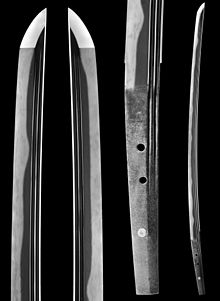Nihon bijutsu token hozon kyokai

Le Nihon bijutsu token hozon kyokai (日本美術刀剣保存協会) (NBTHK) ou « Société pour la préservation de l'art des sabres japonais » est un organisme du gouvernement japonais dont la mission est l'enregistrement et la conservation des anciens sabres japonais.
L'Agence pour les affaires culturelles fonde le NBTHK en 1948, en réponse à l'interdiction alliée portant sur les sabres japonais après la Seconde Guerre mondiale[1],[2].
Le NBTHK organise des concours annuels pour les forgerons contemporains, qui constituent le point culminant du calendrier de la fabrication des sabres japonais. Un succès dans cette compétition est une haute distinction[3].
La Société émet des certifications pour les sabres anciens. Il existe quatre niveaux de classification dans ce système : hozon (digne de conservation), tokubetsu hozon (œuvre de haute valeur digne de protection), juyo token (sabre important) et tokubetsu juyo token (valeur et importance la plus haute)[4],[5]. Une certification par le NBTHK peut décupler la valeur de revente d'un sabre[6]. Le NBTHK est également responsable du musée du sabre japonais situé à Tokyo[1].
Notes et références
[modifier | modifier le code]- (en) Cet article est partiellement ou en totalité issu de l’article de Wikipédia en anglais intitulé « Nihon Bijutsu Token Hozon Kyokai » (voir la liste des auteurs).
- « Police Raid Society for Preservation of Japanese Art Swords » [archive du ], Japan Probe (consulté le ).
- ,Nicole Coolidge Rousmaniere, British Museum, Kokuritsu Kindai Bijutsukan (Japan), Kyōto Kokuritsu Kindai Bijutsukan, Nihon Kōgeikai et Kokusai Kōryū Kikin, Crafting Beauty in Modern Japan: Celebrating fifty years of the Japan traditional art crafts exhibition, University of Washington Press, (ISBN 978-0-295-98733-0, lire en ligne), p. 13.
- Leon Kapp, Hiroko T. Kapp et Yoshindo Yoshihara, Modern Japanese Swords and Swordsmiths : From 1866 to the Present, Kodansha International, , 224 p. (ISBN 978-4-7700-1962-2, lire en ligne), p. 7.
- Worth, CurtCo. Publishing, (lire en ligne), p. 84.
- « Tosogu Kanteisho », Nihonto Kanji (consulté le ).
- Myles J. Connor et Jenny Siler, The Art of the Heist: Confessions of a Master Art Thief, Rock-and-Roller, and Prodigal Son, HarperCollins, , 294 p. (ISBN 978-0-06-167228-6, lire en ligne), p. 132.
Voir aussi
[modifier | modifier le code]Liens externes
[modifier | modifier le code]- (en) « Site du NBTHK »(Archive.org • Wikiwix • Archive.is • Google • Que faire ?).
- (en) « Site du musée des sabres japonais », sur www.touken.or.jp (consulté le ).
Text is available under the CC BY-SA 4.0 license; additional terms may apply.
Images, videos and audio are available under their respective licenses.
